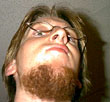|
|
This topic comprises 2 pages: 1 2
|
|
Author
|
Topic: 16 ft lamberts...
|
John Wilson
Film God

Posts: 5438
From: Sydney, Australia.
Registered: Dec 1999
|
 posted 07-07-2001 07:00 AM
posted 07-07-2001 07:00 AM




I had a curious thing the other day. I called in the tech to take a look at one of our new screens with a light meter as it seemed much darker than it should be...(compared to our other screens, that is).He took a look at it and found there to be 15 ft lamberts on the scope image...a little under, but not too much. Still, it looked very dark so we decided to take a look at the others. We found them all running in range from 16 to 22 ft lamberts, hence my thinking the new one was so dark. But here's my question...is 16 ft lamberts really enough? Are we selling ourselves short by lowering the bar to accomodate theatres that simply can't (or won't) get anywhere near the correct luminence on screen? The 22 screen was a bit bright and has been dropped a little (this would explain everyone touring the booth commenting on how lovely and bright the images were), but it actually looks great at 18/19/20 ft lamberts and pretty darn ordinary at 16. Unfortunately, the lightmeter was worth $4000 so it's not like we will be buying one to check on them but I was truly surprised at just how ordinary an image at 16 ft lamberts looks. I know the prints are made to run at 16, but do the producers actually think it to be enough or are they just putting up with a standard because they believe it untouchable to achieve a brighter image? I'm curious...what do you guys think? ------------------
"If you think THIS is fantastic...wait until you see the full effect with the HIMP projected at 19 ft lamberts!"
- Chief Inspector Clouseau (who, little as it was known, used to dabble in the booth from time to time).
| IP: Logged
|
|
John Pytlak
Film God

Posts: 9987
From: Rochester, NY 14650-1922
Registered: Jan 2000
|
 posted 07-07-2001 07:44 AM
posted 07-07-2001 07:44 AM





Standard SMPTE 196M has an aim of 16 footlamberts. When prints are color timed by the lab, the decisions are made by viewing the prints in a screening room carefully maintained at the 16 footlambert aim --- in other words, the prints are OPTIMIZED for projection at 16 footlamberts.I agree that image quality usually improves at higher screen luminance. Highlights sparkle, colors are more saturated, there is more detail in the dark shadows, and the prints even appear to be sharper. But shutter flicker becomes more noticable at higher luminance -- with a two blade shutter at 24fps (48 interruptions per second), flicker starts to become very noticable at about 25 footlamberts. A higher frame rate could be used (e.g., Todd-AO 30fps, ShowScan 60fps), or a less efficient 3-blade shutter could be installed (72 interruptions per second at 24fps) to reduce shutter flicker. But the current standard is 24fps, and most theatres would be unwilling to double lamp power to compensate for the less efficient 3-blade shutter. SMPTE 196M does allow a range of 12 to 22 footlamberts for theatres. At 22 footlamberts, perceived flicker with a two-blade shutter is still at an acceptable level. So why not use 22 footlamberts as the aim, since pictures will look "better"? The answer is that although the pictures may look "better", they won't reflect what the director and cinematographer intended as they made color timing decisions in the lab screening room at 16 footlamberts. You may see detail in the shadows that they did not want you to see. The more saturated colors may not reflect the pastel look they were seeking. Or scenes that were slightly underexposed would have "smoky" shadows as more light was visible in the shadows. Dim screens below 12 footlamberts definitely produce INFERIOR images. But although screen luminance much higher than 16 footlamberts may often look "better", it may not reflect what the director and cinematographer intended. You might ask why not raise the aim above 16 footlamberts, so movies are timed at a higher level, say 22 footlamberts? The problem is that most theatres are already below 16 footlamberts, and would then be even farther away from the aim. Lowering the aim below 16 footlamberts is unacceptable, because of the many known disadvantages of low screen luminance, and the adverse effect making "thin" prints has on image quality. So for now, the aim is 16 footlamberts, and theatres should try be be as close to it as possible, within the allowed range of 12 to 22 footlamberts. If you have 22 footlamberts, you are still within standard, and will have very good looking images. But the director and cinematographer may not want your audience seeing the villain lurking in the shadows, or colors that are brighter and more saturated.
Screen Luminance Article ------------------
John P. Pytlak, Senior Technical Specialist
Worldwide Technical Services, Entertainment Imaging
Eastman Kodak Company
Research Labs, Building 69, Room 7419
Rochester, New York, 14650-1922 USA
Tel: 716-477-5325 Cell: 716-781-4036 Fax: 716-722-7243
E-Mail: john.pytlak@kodak.com
Web site: http://www.kodak.com/go/motion
| IP: Logged
|
|
|
|
Stefan Scholz
Expert Film Handler
Posts: 223
From: Schoenberg, Germany
Registered: Sep 1999
|
 posted 07-07-2001 11:30 AM
posted 07-07-2001 11:30 AM





Good, be happy if you reach 16 fl. We have randomly tested screen luminance in existing "premier" theatres in Germany. With many of them the liminousity did not even reach 22 cd/mē (about 5 fl) in center with significant dropoff to the sides. The reasons were different, you are actually able to get 62 cd/mē (17 fl) on a 1.8 gain 62 ft screen with scope, using a standard Kinotone FP 30D with 5 k lamp and matched lens, with 20 % dropoff to the sides. It is just a matter of spending some time to correctly align the lamphouse. And USL's PSA 200 screen analizer on hand.
The case above was a mismatch of reflector - lens type characteristics.
Films may be monitored at 16 fl, but on the other hand keep in mind, it is not that much above our eyes night vision. (At night all cats are grey) Slight increases in luminosity will significantly improve color schemes, sharpness and contrast reception. So my feeling is that 16 fl should be maintained, and some extra fl could not be worse, as long as you do not exceed 22 fl.
According to my knowledge, at 30 fps (Todd AO) the perceived flicker may be noticeable at 150+ fl, which would certainly superceed the goal.
I like bright pictures. I hate the dim screens mentioned above, they just exist, not by lack of knowledge, just by a "not want to" attitude.
| IP: Logged
|
|
|
|
Steve Guttag
We forgot the crackers Gromit!!!

Posts: 12814
From: Annapolis, MD
Registered: Dec 1999
|
 posted 07-07-2001 01:26 PM
posted 07-07-2001 01:26 PM




I am a firm believer in that screen size and screen brightness are interelated. A small appeaing image underilluminated looks God-awful. A Large or extrememly large appearing image under illuminated looks ok. Take IMAX for instance, they are lucky to get double digit brightness...many are at or around 8fL (2-D). Does anyone complain about the poor picture quality? Nope, normally they are somewhat the measuring bar of how good film can look. In conventional theatres, I have noticed the same trend... a 9fL picture on a 62 foot wide screen doesn't look all that bad, 12 certainly looked better, 16 not as good as 12 but there were other mitigating factors here (screen self-illumination). On a little screen the same is not the case 9fL looks horrible with whites turning into greys. Another factor in all of this is color temperture...some lamphouse manufacturers have high color temp reflectors (near or at 6000K)...this will be a bluer light and appear brighter (TV manufacturers do this too, by the way). 5400K is the standard for Xenon and films really do look better at 5400 than 6000K if they are timed that way...flesh tones practically jump out at you. I recently set up a theatre and they have smaller screens (all 12 feet tall) and for scope we get 22fL...there is no objectionable flicker (single bladed shutters) and the pictures have a lot of "snap" to them...very sharp (good lenses too). The flat pictures are between 14 and 18fL (some have vertical masking, sorry the physical size of the theatre on four screens prohibited side movable, damn it). 14fL looks ok unless you compare it to a brighter picture (which the audience doesn't get to do). One issue with bright (22fL) pictures is that the blacks start to turn other colors (grey or green mostly) as the lower limit of the film, as exposed, is reached. Also your masking better be jet black (velour or better!) because plain old Duevityne (sp?) will not hide any aperture shaddow well at that brightness. I recently set up a lab...to answer your question, they have 16fL +/- .5fL anywhere on the screen and are filterd to 5400K. They can project 16mm, S-16mm and 35mm...the lamphouse is readjusted for 16fL in all modes. One of the tricks for obtaining balanced light between the formats (in theatres as well) is to use stop down rings on the more light efficient formats. For instance, if you have over 22fL on Scope but about 19 fL on Flat, try stopping down the Scope lens to f/2.4...the balance will be better an the focus will improve for the stopped down lens! Steve ------------------
"Old projectionists never die, they just changeover!"
| IP: Logged
|
|
|
|
|
|
Steve Guttag
We forgot the crackers Gromit!!!

Posts: 12814
From: Annapolis, MD
Registered: Dec 1999
|
 posted 07-07-2001 05:34 PM
posted 07-07-2001 05:34 PM




Adam:If you are a 3-D house then yes, the silver screen will have a 2X-3X effect on the brightness BUT you are only getting that in the center, the silver IMAX 3-D screens hot spot just like all silver screens not heavily curved. When I referred to 2-D IMAX, I was referring to Matte-White or very low gain white screens....It has been my finding that they are in the single digit luminance. Steve ------------------
"Old projectionists never die, they just changeover!"
| IP: Logged
|
|
|
|
Steve Guttag
We forgot the crackers Gromit!!!

Posts: 12814
From: Annapolis, MD
Registered: Dec 1999
|
 posted 07-07-2001 07:48 PM
posted 07-07-2001 07:48 PM




Adam,I just checked with one of my IMAX buddies...he said in his 3-D IMAX, they had between 24-28 fL in the middle with both 15K lamps (3-D mode) buring. That typical IMAX 2-D theatre are 8-12fL. Furthermore, some 2-D prints are specific to the theatre format...that is Fantasia 2000 was struck for 2-D and 3-D theatres (presumed timed differently) so the brightness looks proper. Steve ------------------
"Old projectionists never die, they just changeover!"
| IP: Logged
|
|
|
|
|
|
Steve Guttag
We forgot the crackers Gromit!!!

Posts: 12814
From: Annapolis, MD
Registered: Dec 1999
|
 posted 07-08-2001 02:00 AM
posted 07-08-2001 02:00 AM




Actually,Christie has had their SLC console adjust the lamp between flat and scope for some time! Steve ------------------
"Old projectionists never die, they just changeover!"
| IP: Logged
|
|
|
|
|
|
All times are Central (GMT -6:00)
|
This topic comprises 2 pages: 1 2
|
Powered by Infopop Corporation
UBB.classicTM
6.3.1.2
The Film-Tech Forums are designed for various members related to the cinema industry to express their opinions, viewpoints and testimonials on various products, services and events based upon speculation, personal knowledge and factual information through use, therefore all views represented here allow no liability upon the publishers of this web site and the owners of said views assume no liability for any ill will resulting from these postings. The posts made here are for educational as well as entertainment purposes and as such anyone viewing this portion of the website must accept these views as statements of the author of that opinion
and agrees to release the authors from any and all liability.
|

 Home
Home
 Products
Products
 Store
Store
 Forum
Forum
 Warehouse
Warehouse
 Contact Us
Contact Us




 Printer-friendly view of this topic
Printer-friendly view of this topic




















